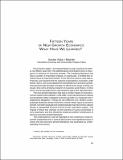Mostrar el registro sencillo del ítem
Fifteen years of new growth economics: what have we learned?
| dc.contributor.author | Sala-I-Martin, Xavier | |
| dc.date.accessioned | 2019-11-01T00:01:32Z | |
| dc.date.available | 2019-11-01T00:01:32Z | |
| dc.date.issued | 2002 | |
| dc.identifier.isbn | 956-7421-137 | |
| dc.identifier.uri | https://hdl.handle.net/20.500.12580/3680 | |
| dc.description | Paul Romer’s paper, “Increasing Returns and Long-Run Growth,” is now fifteen years old. This pathbreaking contribution led to a resurgence in research on economic growth. The resulting literature has in had a number of important impacts. In particular, it shifted the research focus of macroeconomists. From the time when Lucas, Barro, Prescott, and Sargent led the rational expectations revolution until Romer, Barro, and Lucas started the new literature on economic growth, macroeconomists devoted virtually no effort to the study of long-run issues, they were all doing research on business cycle theory. In this sense, the new growth theory represented a step in the right direction. | |
| dc.format | ||
| dc.format.extent | Sección o Parte de un Documento | |
| dc.format.medium | p. 41-59 | |
| dc.language.iso | eng | |
| dc.publisher | Banco Central de Chile | |
| dc.relation.ispartof | Series on Central Banking, Analysis, and Economic Policies, no. 6 | |
| dc.rights | Attribution-NonCommercial-NoDerivs 3.0 Chile | * |
| dc.rights.uri | http://creativecommons.org/licenses/by-nc-nd/3.0/cl/ | * |
| dc.subject | DESARROLLO ECONÓMICO | es_ES |
| dc.subject | MACROECONOMÍA | es_ES |
| dc.subject | CICLOS ECONÓMICOS | es_ES |
| dc.title | Fifteen years of new growth economics: what have we learned? | |
| dc.type.doc | Artículo | |
| dc.file.name | BCCh-sbc-v06-p041_060 |


